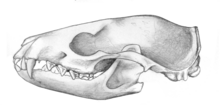Gustafsonia
|
Gustafsonia Temporal range: 39–33 Ma Eocene to Oligocene |
|
|---|---|
 |
|
| Scientific classification | |
| Kingdom: | Animalia |
| Phylum: | Chordata |
| Class: | Mammalia |
| Order: | Carnivora |
| Family: | †Amphicyonidae |
| Genus: |
†Gustafsonia Tomiya & Tseng, 2016 |
| Species: |
Gustafsonia cognita (Gustafson, 1986) |
Gustafsonia is an extinct genus of carnivoran belonging to the family Amphicyonidae (a bear dog). The type species, Gustafsonia cognita, was described in 1986 by Eric Paul Gustafson, who originally interpreted it as a miacid and named it Miacis cognitus. It was subsequently considered to be the only species of the diverse genus Miacis that belonged to the crown-group Carnivora, within the Caniformia, and it was ultimately assigned to the family Amphicyonidae. The type specimen or holotype was discovered in Reeve's bonebed, western Texas, in the Chambers Tuff Formation in 1986. The University of Texas holds this specimen. It is the only confirmed fossil of this species.
The holotype is missing the mandible, upper canines, and zygomatic arch. The remainder of the skull is damaged, but relatively intact.
It preserves the old style of many teeth, probably having forty-two, as compared to most modern carnivorans in the low thirties. With the later species of Miacis, the size of the certain teeth were decreasing, namely the foremost premolars. These teeth would eventually be lost all together, resulting in the fewer number of teeth seen in most modern carnivorans, especially feliforms, including extant hyenas, viverrids, herpestid, and the famously few-toothed felids. Most members of Miacoidea have forty four teeth, so this advanced species has already lost two bottom premolars. Though the upper canines are missing, these teeth can be reconstructed due to the foramen for the tooth root remaining intact. These canines were not particularly long or short, though they were not stout or shaped for great stress. The molars of this species were small and not suited for grinding large amounts of material. The premolars show carnassial form that makes carnivorans unique and were good for slicing rather than crushing or grinding.
...
Wikipedia
